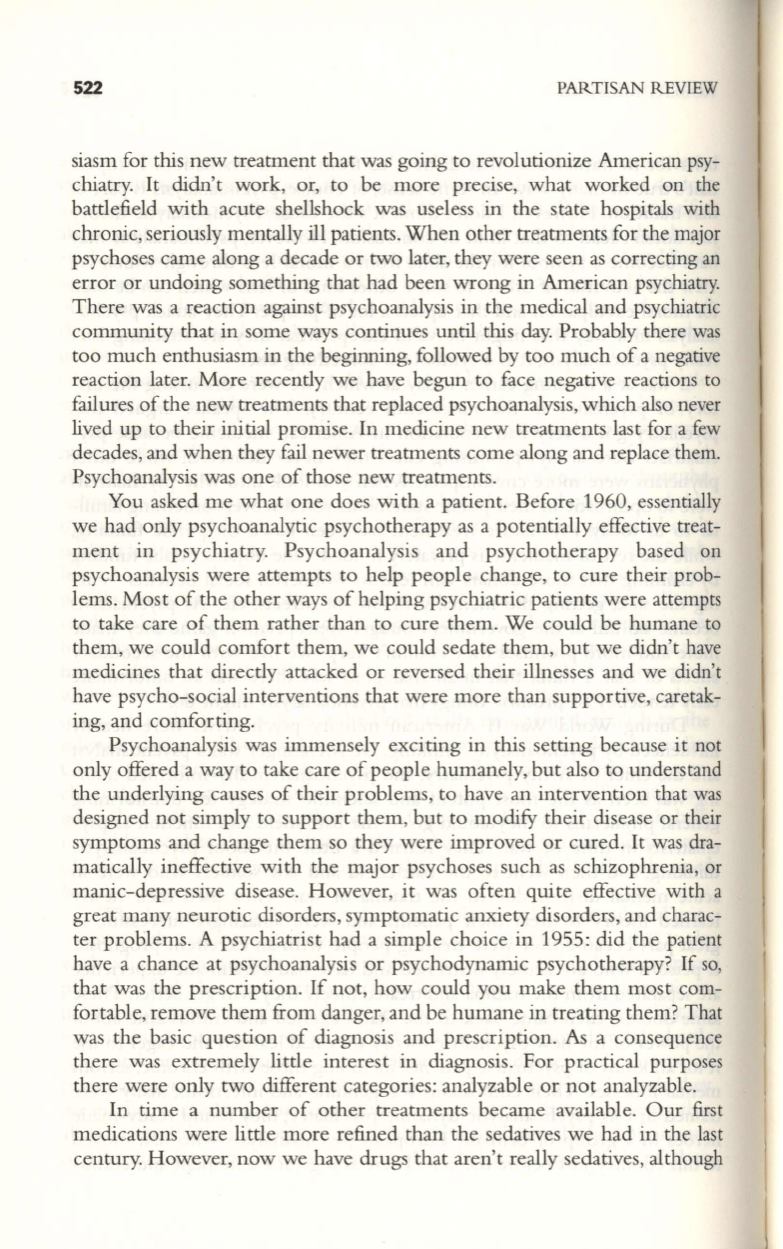
522
PARTISAN REVIEW
siasm for this new treatment that was going to revolutionize American psy–
chiatry. It didn't work, or, to be more precise, what worked on the
battlefield with acute shellshock was useless in the state hospitals with
chronic, seriously mentally
ill
patients. When other treatments for the major
psychoses came along a decade or two later, they were seen as correcting an
error or undoing something that had been wrong in American psychiatry.
There was a reaction against psychoanalysis in the medical and psychiatric
community that in some ways continues until this day. Probably there was
too much enthusiasm in the beginning, followed by too much of a negative
reaction later. More recently we have begun to face negative reactions to
failures of the new treatments that replaced psychoanalysis, which also never
lived up to their initial promise. In medicine new treatments last for a few
decades, and when they fail newer treatments come along and replace them.
Psychoanalysis was one of those new treatments.
You asked me what one does with a patient. Before 1960, essentially
we had only psychoanalytic psychotherapy as a potentially effective treat–
ment in psychiatry. Psychoanalysis and psychotherapy based on
psychoanalysis were attempts to help people change, to cure their prob–
lems. Most of the other ways of helping psychiatric patients were attempts
to take care of them rather than to cure them. We could be humane to
them, we could comfort them, we could sedate them, but we didn't have
medicines that directly attacked or reversed their illnesses and we didn't
have psycho-social interventions that were more than supportive, caretak–
ing, and comforting.
Psychoanalysis was immensely exciting in this setting because it not
only offered a way to take care of people humanely, but also to understand
the underlying causes of their problems, to have an intervention that was
designed not simply to support them, but to modifY their disease or their
symptoms and change them so they were improved or cured. It was dra–
matically ineffective with the major psychoses such as schizophrenia, or
manic-depressive disease. However, it was often quite effective with a
great many neurotic disorders, symptomatic anxiety disorders, and charac–
ter problems. A psychiatrist had a simple choice in 1955: did the patient
have a chance at psychoanalysis or psychodynamic psychotherapy? If so,
that was the prescription. If not, how could you make them most com–
fortable, remove them from danger, and be humane in treating them? That
was the basic question of diagnosis and prescription. As a consequence
there was extremely little interest in diagnosis. For practical purposes
there were only two different categories: analyzable or not analyzable.
In time a number of other treatments became available. Our first
medications were little more refined than the sedatives we had in the last
century. However, now we have drugs that aren't really sedatives, although


